Abstract
In recent years, prefabricated housing has become increasingly popular and widely promoted due to its potential to improve the construction environment, quality and productivity. To develop prefabricated housing and address housing challenges, the Chinese government is encouraging prefabricated public housing. Consequently, evaluating the environmental performance of prefabricated public housing to identify whether it is environmentally friendly and worthy of investment is urgently needed. This paper compares the costs and benefits of prefabricated public projects and traditional projects based on a questionnaire and field investigation. The paper introduces information from the collected questionnaires on the respondents and projects in Beijing; this information includes the prefabrication rate, technology application, barriers, and industrial performance. The paper also reports a cost-benefit analysis of the changing rates of construction costs and environmental benefits (energy consumption, water usage, construction waste, steel and concrete usage, dust and noise pollution) by using the ∆B/∆C ratio to show the efficiency of prefabricated housing. The results indicate that the ratio is 1.81, which exceeds 1; therefore, investment in prefabricated public housing is environmentally acceptable and efficient. This paper also discusses the efficiencies in different categories and structures with and without incentives. The results show that the costs are higher and the environmental benefits are efficient but not significant; thus, promoting prefabricated public housing is necessary.
1. Introduction
With the rapid growth of the economy, issues such as income inequality, housing challenges, depletion of natural resources, and environmental pollution have arisen in China. Traditional construction as a labour-intensive on-site method has been criticized for low productivity and intermingled quality [1,2,3,4]. To meet housing quantity and quality requirements, to reduce the labour costs [5,6] and to achieve industry transformation, the government is promoting prefabrication techniques in construction with great effort.
China started housing industrialisation with pilot work in 2008. Since 2010, the government has implemented at least 15 policies and standards to improve the development of prefabrication, including incentive measures, quality and security regulatory measures, and technical support measures. The government has also established a housing industrialisation joint meeting system, a leadership group and a committee of housing industrialisation experts. China has set clear goals; for example, the Outlines for the Development of Construction Industrialisation states that prefabricated buildings should ideally represent 20% and 50% of new buildings by 2020 and 2025, respectively. More than 30 provinces have passed some related policies and supportive measures to reach those goals. Although these policies are various in different areas, public housing as a pilot project is an important measure to promote prefabricated technology due to the governmental support and enforcement, as well as its small apartment layouts and simple designs which is suitable for prefabricated construction.
The government plays an important role in developing prefabricated public housing. By 2014, there were more than 70 prefabricated public housing projects planned in Beijing. Since October 2014, all public housing has been constructed using prefabrication techniques. The Beijing government is working towards the promotion of prefabricated public housing to improve prefabrication techniques, particularly through Document 315 [7], which states that prefabricated public housing is an important part of green buildings. The precast components, such as precast laminated floor slabs, precast stairs, precast balcony slabs, and precast air-conditioning boards, should be fully used for all types of public housing construction.
In addition to higher quality and less labour input, it is also necessary to analyse other benefits that prefabricated construction can bring. Relative to traditional construction mode, some research found that prefabricated housing can reduce the mobility of workers and ease problems caused by transportation. Especially in the USA, Singapore and Hong Kong, the researchers found that prefabricated construction also requires smaller quantities of construction materials such as concrete and steel [8], significantly reduces construction waste [9], increases design efficiency and productivity, reduces construction time scales, improves quality, decreases pollution [10], increases the accuracy rate, uses less land and provides sustainable construction methods [11]. Some researchers also point out that prefabricated construction is cost-efficient to a certain extent because it has advantages in terms of labour and material saving. Ogyiri (2014) found that all the precast floor slabs can reduce costs, and the residential facility saved the most in Ghana [12]. Oranga (2012) found that prefabricated houses can alleviate the housing problems in Kibera because of locally available materials and lower costs [13]. Kasper and Anne (2013) found that prefabricated housing in Denmark is cost efficient for construction and energy efficient to operate [14]. Pan and Sidwell (2011) indicated that new technology could reduce costs up to 25% cost from its first use to more regular use in the UK [15].
Although the aforementioned research has analysed the costs and benefits of prefabricated construction, it is doubtful whether the results are suitable for China because China’s prefabricated housing remains at an early stage of development. In addition, some research is based on timber structures via sampling surveys while there are large quantities of concrete structures in China, which may encounter some construction problems and challenges. Therefore, special research efforts were made to address selected issues of prefabricated public housing in China. There have been abundant prefabricated public housing projects as samples in China to date, and this research is also supported by the Beijing Public Housing Office, which is representative to analyse costs and benefits of prefabricated technology. Therefore, the main objectives of the present paper are outlined as follows:
- To introduce the general condition of prefabricated public housing in Beijing using a questionnaire and field investigation based on multiple projects;
- To identify construction costs and environmental benefits based on a cost-benefit analysis (CBA) framework;
- To determine whether prefabrication is better and more efficient than traditional methods in terms of construction costs and environmental impact; and
- To explore the policies and limitations related to the development of prefabricated housing.
This study investigated most public projects in Beijing; thus, the study is more representative than previous studies, and the results reflect a general situation in Beijing. First, in the Analytical Framework section, this paper introduces an analytical framework to show the whole idea of the topic. Second, in the Methodology section, the paper introduces two methodologies (questionnaire survey and cost-benefit analysis) to analyse the topic. Third, in the Results section, the paper shows the results collected via questionnaires and analysed using the cost-benefit model. Finally, in the Discussion section, the paper discusses and compares the environmental efficiency with and without government incentives and addresses the efficiency and main barriers in different categories and structures.
Although this paper is based on surveys in China and the results are limited to China, the findings are valuable to other countries whose prefabricated construction or housing industrialisation is also at an early stage. China is acknowledged worldwide as having the largest volume of building and infrastructure construction. The cost disadvantage and barriers in China may indicate that not all advanced construction technologies can be implemented smoothly or adequately exert their advantages at the early stages, which is an alert for those countries that have planned to promote prefabricated construction. Meanwhile, the findings and policy implications from China can provide references for those countries facing the similar problems to make targeted policies. The specific contributions include the following: (1) a new CBA framework is developed to improve the prefabricated construction environment while considering costs; (2) the empirical results indicate a relationship between construction costs and environmental benefits with first-hand quantitative and qualitative data; (3) this study examines policies and limitations, which is conducive to finding useful solutions for promoting prefabricated housing.
2. Analytical Framework
This paper assesses whether prefabricated public housing is environmentally efficient relative to traditional housing. The analytical framework in this paper is developed to provide an in-depth understanding of the general environmental efficiency of prefabrication efforts in Beijing. Therefore, the scope of analysis should be defined, and the cost and environmental benefits should be classified.
2.1. Analytical Scope
The scope relies on the subjects, and the areas of study include the system boundary and the level of detail [16]. This study analyses the general conditions within the context of Beijing. Therefore, we aimed to investigate all prefabricated public projects in Beijing as research objects. Relative to traditional housing, the largest differences in terms of costs and environmental benefits occur during the construction period. During the operation period, environmental impacts are associated with maintenance, heating, ventilation, lighting, and hot water, among other factors [17], which depend on climate, indoor space and user behaviour [18]. Hence, the analytical scope of this study focuses on the construction period to analyse all prefabricated construction projects in Beijing.
2.2. Construction Costs
A unique aspect of prefabricated housing is the precast pieces, including precast laminated floor slabs, precast stairs, precast balcony slabs, and precast air-conditioning boards. Because of the variety of construction methods, various construction costs arise. In the prefabricated construction mode, costs consist mainly of precast component costs (e.g., materials, labour, machines, and transportation), cast-in-situ concrete costs, and on-site construction costs (e.g., unloading, installation, and lifting and storage). In the traditional construction mode, the costs consist mainly of cast-in-situ part costs (e.g., components and concrete) and on-site construction costs [19].
2.3. Environmental Benefits
In accordance with life-cycle analysis (LCA) theory and the Building Environmental Performance Analysis System (BEPAS), environmental impacts include ecological damage and resource depletion [18]. Thus, in considering the construction process in this study, we focus mainly on the environmental performance in terms of energy consumption, water usage, construction waste, steel and concrete usage, dust and noise pollution.
In summary, from the aforementioned scope and the types of cost and environmental benefits, the analytical framework can be developed, as shown in Figure 1.
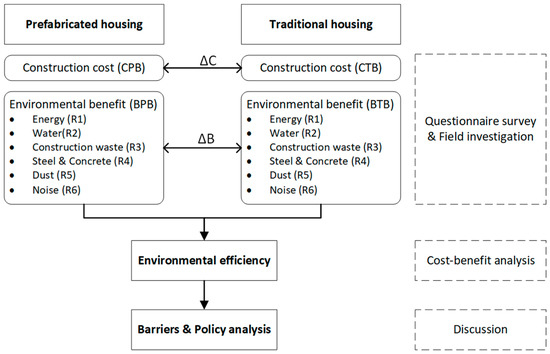
Figure 1.
Analytical framework.
3. Methodology
3.1. Questionnaire Survey
This paper investigated almost all prefabricated public housing projects in Beijing via questionnaire and field investigation. The respondents were drawn from a list of the developers provided by the Beijing Public Housing Office. The questionnaire was implemented on behalf of the Beijing Public Housing Office to ensure the timeliness and effectiveness of the study.
The questionnaire design followed the principles of quantitative and qualitative research. The questionnaire consists of two parts. The first part seeks basic information related to the respondents and projects, including the respondents’ position, experience, prefabrication rate (PR), assembly rate (AR), schedule, area, and types of prefabricated projects. Prefabricated housing can be characterised mainly by standardisation and integration. PR and AR are the main indicators showing the level of prefabricated housing.
The second part concerns the detailed performance of projects, such as the construction costs, environmental performance, and barriers. According to the analytical framework, we configured indexes as follows: (1) management and performance and (2) policy assessment (Figure 2). The first part is based on the Standard for Assessment of Industrialised Building (GB/T 51129-2015). This national standard is suitable for assessing the industrialised level of residential buildings. The standard can be used to assess prefabricated buildings in a comprehensive way and identify their main features. The second part is based on a literature review and field investigation.
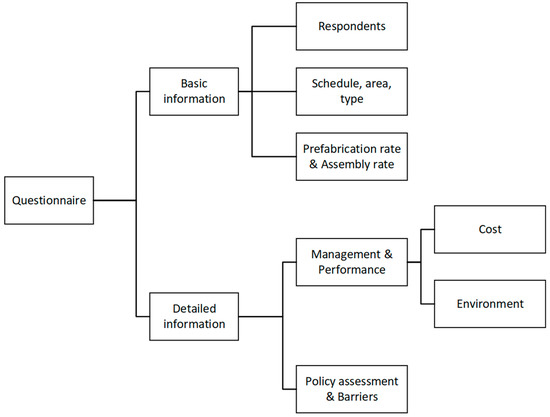
Figure 2.
Structure of the questionnaire.
3.1.1. Management and Performance
To analyse whether prefabricated housing is more efficient than traditional housing, management and performance factors are important. Therefore, cost and environmental performance are taken as management and performance indexes to identify the benefits of prefabricated housing relative to traditional housing.
In accordance with the analysis framework, in this questionnaire, we focus on environmental performance regarding energy consumption, water usage, construction waste, steel and concrete usage, and dust and noise pollution when considering the construction process. The questionnaire aims to find the changing rates of cost and environmental performances by comparing prefabricated housing with traditional housing.
3.1.2. Policy Assessment and Barriers
The development of prefabricated housing can also be influenced by policies. Therefore, we considered stimulation policies and barriers to determine whether these policies are useful and how many key factors might hinder prefabricated public housing development. There are six common incentive methods, i.e., construction area rewards, lending priority, enterprise income tax reduction or exemption, subsidy for special funds, and payment of land-transfer fees by instalment and green passage.
There are some barriers and challenges during the development such as slow project progress, high cost, poor quality, unreasonable design, and insufficient technology levels. Zhang et al. (2014) compared the direct costs of a concrete wall panel between prefabricated housing and traditional housing, and found that the direct cost of prefabricated housing is larger than that of traditional housing, although prefabricated housing can reduce more labour costs [20]. Even in the USA, Arditi et al. (2000) found that a precast concrete system did not achieve cost savings but believed that it would be more economical with the improvement of expertise and communication [21]. Some factors can influence prefabricated housing development; these factors may include high initial costs, high labour input, inflexible design [11], lack of skilled workers, incomplete supply chain, imperfect standards [22], consumers’ opinion and market demand [23]. Cao et al. [24] found four major factors that restricted the application and popularity of the skeleton and infill (SI) system housing in China, including costs and benefits, technology and management, industrial chain and enterprise capacity. Jiang et al. [25] extracted four factors: industry chain, cost, social climate and attitudes, and risk. Steinhardt et al. (2014) analysed the challenges from the perspective of suppliers, intermediaries, users, policy environment and technology [26]. In addition to the aforementioned barriers, more barriers have been identified by researchers (Table 1).

Table 1.
Review of major barriers.
According to the literature review and field research, we identified 10 obstacles to prefabricated public housing, and each question represents one factor hindering the adoption of prefabricated housing (Table 2). The influence of barriers to prefabricated public housing can be evaluated by a five-point Likert scale, in which 5 represents “strongly hinders” and 1 represents “negligibly hinders”.

Table 2.
List of major barriers in the questionnaire.
3.2. Cost-Benefit Analysis
CBA has been widely used in decision-making processes [37] and in environmental assessments [38,39,40]. Generally, costs encompass all funds and the actual material consumption of projects, including direct costs and external indirect costs. Benefits involve the contributions of the projects to the national economy, resource conservation, and environmental protection, among other components, including direct benefits and indirect benefits. This analysis method has been used in urban renewal projects [41,42], green buildings [43,44] and low-cost housing [45]. However, the method has seldom been applied to prefabricated housing. Hong et al. [36] established a CBA framework to find the cost composition and analyse the costs of real prefabricated projects. Previous studies have assessed the comprehensive benefits, including advantages for the economy, environment and society [46,47], but these indexes indicated only the benefit level of prefabricated housing. The interactions between the costs and benefits have not been exploited. To analyse whether prefabricated housing merits investment and is environmentally friendly, this paper focuses on environmental benefits, and the benefits considered are related mainly to environmental performance.
CBA is based on incremental costs and benefits, and a suitable CBA in this context compares prefabricated buildings with traditional buildings [43]. Simply put, prefabricated housing is a worthwhile investment if the total benefits are greater than the incremental costs, which is expressed mathematically as follows:
where BPB denotes the benefits of prefabricated buildings, BTB denotes the benefits of traditional buildings, CTB denotes the costs of traditional buildings, and CPB denotes the costs of prefabricated buildings.
BPB − BTB ≥ CPB − CTB,
The benefit-to-cost ratio (B/C) of the investment can also be used to describe the projects:
B/C = (BPB − BTB)/(CPB − CTB).
If the B/C ratio is equal to or greater than one, then the investment in prefabricated housing is considered acceptable. If the ratio is less than one, then the investment is not acceptable [48].
The two methods mentioned above are based on absolute indexes, which can be used to compare two similar projects. However, to analyse other types of projects, the absolute indexes cannot reflect an average condition because different projects may have significant differences and gaps. Therefore, relative indexes are used to compare the costs and benefits to analyse whether the investment is worthwhile regardless of significant differences or gaps. The paper considers the rate of change to compare the efficiency of the projects. In the questionnaire, we compared the increasing/decreasing rate of the cost and environmental performance of prefabricated housing with those of traditional housing using the expression
where ∆B = (BPB − BTB)/BTB and ∆C = (CPB − CTB)/CTB.
∆B/∆C,
If the ∆B/∆C ratio is equal to or greater than one, then the investment in prefabricated housing is efficient because a lower cost increase can offer more benefit improvement, relatively speaking. If the ratio is less than one, then the investment is not efficient.
Because the model has been established, the components of costs and benefits need to be identified and should be realistic. The traditional approach based on costs often lacks other aspects of benefit evaluation models that are not always considered, such as environment, labour and quality [45]. To define the ∆B/∆C ratio, the hypothetical costs and benefits should be determined in accordance with the performance of the same work scope for site-built processes. The costs encompass all costs of construction. The benefits focus on environmental performance, including the decrease in energy consumption, the conservation of water, the decrease in construction waste, the attrition rate of steel and concrete, and the decrease in dust and noise pollution.
To quantify these benefits in the same dimension, the benefits should be related to the costs, at which point the former can be added together and analysed relative to the latter. In this analysis, energy consumption cost, water fee, waste disposal fee, steel and concrete cost, and dust and noise control fee are considered in the comparison of prefabricated buildings and traditional buildings.
(1) Energy consumption
In the construction site and prefabrication factory, energy consumption includes electricity usage and diesel and gasoline machinery, among which electricity usage is the largest part of energy consumption. According to this investigation, the Beijing construction budget quota [49] and other case studies, the electricity fee accounts for approximately 0.4% of the total construction cost. Diesel and gasoline machinery consumes only 9.52% of the energy [50]. Therefore, diesel and gasoline machinery accounts for 10.52% of the electricity, and we assume that the energy consumption fee for machinery accounts for 0.44% of the total cost.
(2) Water usage
Water is a major component of construction resources. In the construction period, water is used for concrete production and curing and site cleaning, among other uses. According to this investigation, the Beijing construction budget quota and other case studies, the water fee accounts for approximately 0.3% of the total cost.
(3) Construction waste
A large amount of construction waste is present on site, particularly in the case of traditional building sites. Depending on building type, there are different proportions and types of construction wastes [51], such as bricks, concrete, steel, timber, and mortar. According to this investigation, the Beijing construction budget quota and other case studies, the waste disposal fee accounts for approximately 0.2% of the total cost.
(4) Steel and concrete
Steel and concrete are primary construction materials, particularly for reinforced concrete buildings. Across China, 1.5 billion tons of concrete is consumed per year, and construction steel accounts for 25% of all material consumption. Each square metre of a building requires approximately 55 kg of steel, which is 10–25% more than the average rate for developed countries [52]. Therefore, it is worthwhile calculating the attrition rate of steel and concrete so that we can analyse how much material can be saved. According to this investigation, the Beijing construction budget quota and other case studies, the costs of steel and concrete account for 25% and 20% of the total cost, respectively.
(5) Dust and noise
The construction process causes pollution, including dust and noise, which has a particularly bad effect in urbanised territories [53]. Dust and noise must be monitored on site so that they can be controlled; however, they cannot be totally eliminated. According to Huang [54], 32.1% of dust in cities is construction dust. Researchers previously monitored dust emissions in Beijing and found that most dust was emitted during major structure, secondary structure and decoration stages [55]. Currently, dust is controlled by wet methods (e.g., water) and equipment (e.g., air cleaners and exhaust hoods) [56]. During constructions, noise lasts the longest during the major structure stage, and it has the largest impact on the surroundings during this stage [57]. Noise control is always more cost effective to implement at the design stage than at the construction stage [58]. Mitigation strategies include source control (e.g., technical specifications and contract clauses), path control (e.g., physical barriers) and receptor control (e.g., humans and equipment) [59]. These methods can be used on either traditional building sites or prefabricated building sites, and the cost of water and equipment can be classified into the water fee and the energy consumption cost. In this paper, dust and noise are not quantified but are discussed qualitatively.
The paper compares the costs of the projects that have increasing rates using four categories of benefits: (1) the energy consumption decrease rate, (2) water savings rate, (3) waste decrease rate, and (4) attrition rate of steel and concrete. If the comprehensive benefits of environmental impacts are higher than the costs, then prefabricated public housing is a suitable investment.
Assuming that the energy consumption fee, water fee, waste disposal fee and cost of steel and concrete account for fi (i = 1,2,3,4) of the total cost, respectively, then these percentages are normalised as weights of the benefits:
where wi is the weight of the cost for category i, and fi is the percentage of the cost attributed to category i.
Then, the environmental benefits can be added together:
where Ri is the changing rate of category i.
The ∆B/∆C ratio can then be defined as:
4. Results
4.1. Basic Information
According to the list, there are 65 recent public housing projects in Beijing. There are 8 projects that could not be contacted because the managers were changed or the contact information changed. Therefore, the questionnaires were sent to the managers of 57 projects, and 50 valid questionnaires were collected. The validity was, therefore, 87.7%; the area of these projects in total comprised more than 9 million square metres.
According to the basic information, 68% of respondents engaged in investment and development, 28% in research and development (R&D) and design, and 4% in construction. Half of the respondents had more than 10 years of experience, and 42% had 5–10 years of experience. Moreover, 80% of the respondents were somewhat familiar with prefabrication, and 12% of respondents knew prefabrication well. In terms of public housing, the starting dates were generally clustered around 2015, and the average duration was 2 years. On average, the prefabricated construction duration for a typical floor is 2 days longer than that in traditional projects, which is different from our expectations. Prefabricated construction has not shown its advantages in China because the slow development, imperfect technology and lack of skilled workers. There were 29 fixed-price housing projects in the 50 investigated public housing projects, 12 public rental housing projects, 6 transformed shanty areas, and 3 other types of public housing. In terms of the structure of the projects, more than half employed a prefabricated shear wall structure, which is the most popular structure for prefabricated public housing in Beijing.
The rates of prefabrication and assembly differ among the projects, and their uneven distribution indicates the imbalance of the industrialisation level. PR and AR are taken from the actual project data. Their frequency distribution appears as a W-type curve. In terms of PR, the rates of most projects are below 10% or over 60%, and the rates of several projects are between 10% and 60% (Figure 3). The average PR of the projects is approximately 36.2%. The situation of AR is similar to that of PR, and the rates of most projects are below 20% or over 70% (Figure 4). The average AR of the projects is approximately 45.3%. This phenomenon is extreme in that these companies either do not wish to develop prefabricated housing or wish to develop it at a high level.
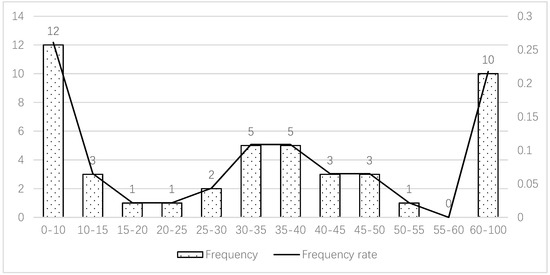
Figure 3.
Histogram of prefabrication rate (PR).
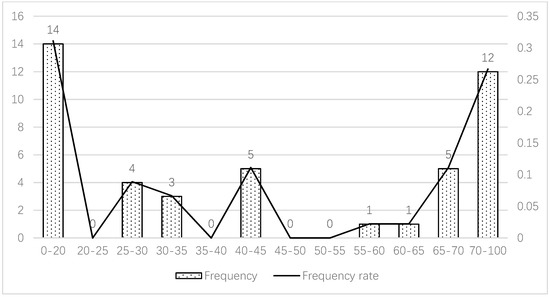
Figure 4.
Histogram of assembly rate (AR).
4.2. Cost and Benefit Results
Among the questionnaires, 36 projects provided detailed cost changing rates and environmental impact changing rates; the corresponding validity was 72%. These data are estimated by the experienced interviewees, and they compared prefabricated projects with their similar traditional projects.
On average, the total costs of the prefabricated projects are higher than those of the traditional projects, and the costs of approximately 36% of the prefabricated projects are 5–10% higher (Figure 5). Only two projects reduce costs, and the costs are 10% lower, which means that their technology and management are relatively cost-efficient.
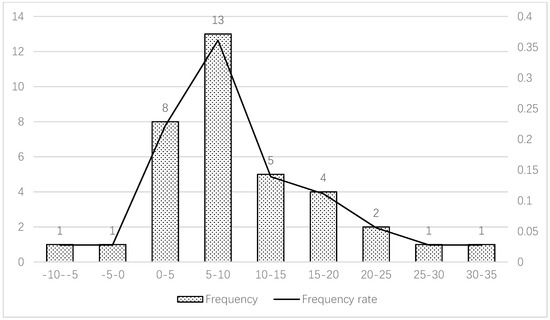
Figure 5.
Histogram of the cost increase rate.
Table 2 indicates that the costs of the prefabricated public buildings are higher than those of traditional buildings; the average excess cost is 9.58%. During the survey, many project managers indicated that the excess costs result mainly from the high cost of components, transportation and installation, a low turnover rate of formworks, immature technology and skills and the lack of advanced management. Generally, because of the longer initial development stage for prefabricated housing, the cost is higher than that of traditional housing, which contradicts the widespread belief that prefabricated construction reduces costs [12,13,20].
Considering environmental impact, on average, construction energy consumption is reduced by 8.33%, water usage is reduced by 11.67%, construction waste is reduced by 12.22%, and the attrition rate of steel and concrete is reduced by 17.5%. The energy consumption of most projects (approximately 41.7%) is reduced by less than 5% (Figure 6), and the frequency distribution appears as a decreasing curve, which means that prefabricated public housing can save some energy, but there is much room for improvement in terms of benefits. Based on the survey, prefabricated construction does not need a large amount of machinery with high energy consumption on site; tower cranes are most commonly used. However, due to limited technology and management, prefabricated construction cannot save a large amount of energy and may even consume more in another form, such as long-distance transportation.
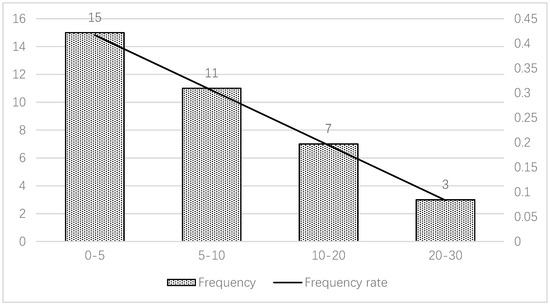
Figure 6.
Histogram of the energy consumption reduction rate.
Relative to traditional projects, the water usage and construction waste of more than half of the projects save less than 10%, and both frequency distributions appear as decreasing curves (Figure 7 and Figure 8). Prefabricated construction can save water and reduce construction waste, but only one or two projects saved 30% to 50% of water and construction waste. Clearly, water savings and waste decreases are not extremely efficient; thus, the advantages of prefabricated housing are insignificant because of limited technology and management.
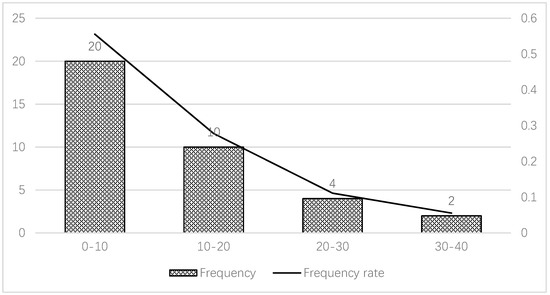
Figure 7.
Histogram of the water usage reduction rate.
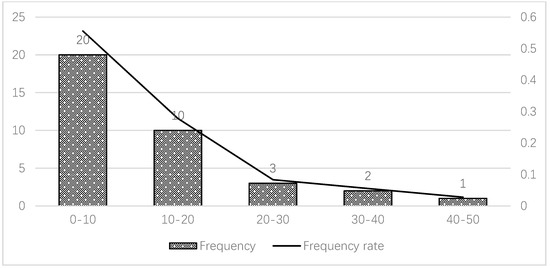
Figure 8.
Histogram of the construction waste reduction rate.
Relative to traditional projects, Figure 9 shows that prefabricated construction can decrease the attrition rate of steel and concrete; the frequency distribution appears as an inverted U curve such that most projects (77.8%) reduce the attrition rate of steel and concrete by 10–30%, which is better in terms of water usage and construction waste. The average attrition is 17.5% lower than that of traditional buildings. The standard deviation is 8.06226, which means that the differences in material attrition in the prefabricated projects are significant and that the effect is below average. Thus, relative to energy consumption, water usage and construction waste, prefabricated housing can offer significant material savings.
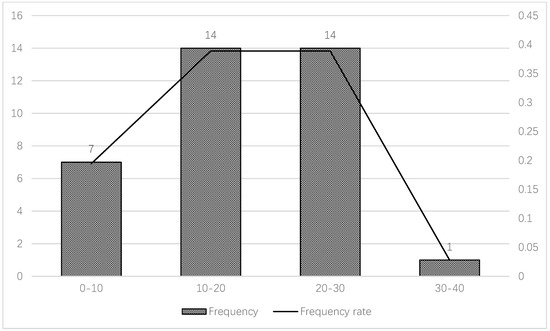
Figure 9.
Histogram of the attrition of steel and concrete.
The questionnaire also considered dust and noise pollution (Table 3). The questionnaire used a five-point Likert scale, in which 5 represents “substantial decrease” and 1 represents “small decrease”. We divided 100% into 5 parts; 5 represents “80–100%”, and 1 represents “0–20%”. The average decrease rates are 33.89% and 20.47% for dust and noise pollution, respectively. Therefore, prefabricated housing can also reduce dust and noise, but the result is below average.

Table 3.
Statistical description of dust and noise.
Regarding environmental impacts, prefabricated housing is more environmentally friendly than traditional housing. These results, that prefabricated housing can bring more environmental benefits, are similar to those of other studies [8,9,10,11]; Cao et al. [6] compared two typical residential buildings with prefabricated technology and on-site technology and found that prefabrication techniques offered certain environmental impact advantages, including reduced resource depletion, ecosystem destruction and health damage. However, the extent of environmental protection (e.g., energy consumption, water usage and construction waste) is not high. Moreover, the standard deviations of these five indexes are relatively large (Table 4), which indicates large differences among the projects and different levels of technology and skills. There are only a few standards for prefabricated technology and skills; thus, the government and enterprises are still performing further research and development to standardise prefabrication technology and skills.

Table 4.
Statistical description of the costs and benefits.
According to this investigation, the Beijing construction budget quota and other case studies, the energy consumption fee accounts for approximately 0.44%, the water fee accounts for approximately 0.3%, the waste disposal fee accounts for approximately 0.2%, and the cost of steel and concrete accounts for approximately 45%. Therefore, the environmental benefit change rate is 17.35% (Table 5).

Table 5.
Environmental benefits.
Since the increase rate of the total cost is 9.58%, the changing benefit-cost ratio is:
∆B/∆C = 17.35%/9.58% = 1.81 > 1.
Therefore, the investment in prefabricated public housing is environmentally acceptable and efficient. Moreover, the ratio is almost two, which means that prefabricated public housing has a significant advantage in terms of environmental benefits.
The results indicate that the attrition of steel and concrete strongly affects ∆B because of the higher material prices. Therefore, excluding material savings, ∆B’ for environmental protection is 10.22% (Table 6). The changing benefit-to-cost ratio is:
∆B’/∆C = 10.22%/9.58% = 1.07 > 1.

Table 6.
Benefits of environmental protection.
Therefore, investment in prefabricated public housing remains an efficient way to protect the environment even though the ratio is close to one. Prefabricated public housing still needs to be developed further, and the efficiency of environmental protection needs to be improved.
In conclusion, prefabricated public housing has significant advantages regarding the environment, particularly in material savings, but prefabricated construction still needs to develop the technology and skills to improve the capacity for environmental protection.
5. Discussion
5.1. Government Incentives
This paper’s analysis of the costs and benefits of prefabricated public housing indicates the general condition of prefabricated public housing in Beijing. To study the policies further, the paper also discusses government incentives, public categories, structures, and barriers.
Eleven projects are supported by the government, and the incentive policies mainly involve construction area rewards and green passage. A construction area reward means that projects can have a certain amount of bonus floor area based on the original planned building areas, in accordance with relevant policies, regulations and technical standards. Green passage helps simplify and prioritise the approval procedures.
To discuss the influence of the government incentives, this study classified these projects into two groups (A1: projects with incentives; A2: projects without incentives). The study used a non-parametric test to compare the influences between these two groups in terms of PR, AR, cost, and environmental performances. The results show that the costs have no significant differences. The government has clearly taken some measures to develop prefabricated public housing, but the results do not have the desired effect, and cost remains a key barrier. Only PR and construction waste attain 70% significance (Table 7). Although the costs show no differences, the PR is increased by government incentives, and much more construction waste can be reduced, possibly through the use of new materials and advanced technology with the assistance of the government. Comparing the ∆B/∆C ratios of the two groups, the ratio of the projects with incentives is 1.84, which is higher than that of other projects (1.77). Therefore, government incentives should still be encouraged, and the incentives need to focus more on costs.

Table 7.
Statistical results regarding government incentives.
5.2. Public Housing Categories
There are five types of public housing in China: public rental housing, low-rent housing, affordable housing, fixed-price housing, and shanty area transformation [60]. According to the investigation, there are 29 fixed-price housing projects, which represent more than half of all projects. Therefore, the study compared fixed-price housing projects (B1) with other housing projects (B2) to determine the reasons why more fixed-price housing projects are chosen. The study used a non-parametric test to analyse the data, and the result is that only cost and water usage have 60% significance (Table 8). The costs of fixed-price housing projects are lower than those of other housing projects, which means that building a fixed-price house is less expensive than building another type of house such that the developers prefer prefabricated fixed-price houses. However, the method of building a prefabricated fixed-price house cannot save more water. Comparing the ∆B/∆C ratios of the two groups, the ratio of the fixed-price houses is 2.17, which is higher than that of other houses (1.61). Therefore, the government should continue to promote fixed-price houses to improve environmental performance and develop other types of houses to reduce costs.

Table 8.
Statistical results regarding the public housing categories.
5.3. Housing Structures
Prefabricated housing can be divided into three categories: prefabricated timber structures, prefabricated steel structures and prefabricated concrete structures. The first two structures are suitable for low-rise houses or villas. In China, concrete structures predominate due to a long history, mature skill development and high structural stiffness. The prefabricated shear wall structure reduces the mass of beams and columns, which is more suitable for specifically producing functional houses with small areas, such as public houses.
There are 32 houses with a prefabricated shear wall structure, which represent more than half of all projects. Comparing the shear wall structure (C1) and other structures (C2), all parts have significant differences at different levels. Table 9 shows that the PR and AR of the shear wall structure are higher than those of other structures. All environmental performances are better than those of the other structures, although the costs are higher. According to the ∆B/∆C ratio of the two groups, the ratio of the shear wall structure is 1.96, which is higher than that of other structures (1.43). Therefore, the prefabricated shear wall structure represents the most suitable structure for prefabricated public housing, and the government should promote this type of structure to decrease costs. In the meantime, other structures should be developed to increase PR and AR and improve environmental performance.

Table 9.
Statistical results regarding the structures.
5.4. Barriers
When analysing the main obstacles, 10 questions (Table 2) are classified into four categories: governmental incentives, industry chain, technology and cost; ‘government incentives’ is assumed to be the main barrier because the prefabricated public projects are significantly influenced by the government and policies. This paper uses Cronbach’s coefficient alpha to evaluate the reliability of the five-point scale. The value of this survey’s test is 0.829, i.e., higher than the 0.6 threshold, which means that the barrier investigation in this paper is reliable. Furthermore, all the barriers classified in this study and listed in Table 10 are statistically qualified. The barriers are analysed by the analytic hierarchy process (AHP) with a hierarchical structure model (Figure 10) [61]. Briefly, ‘scale diseconomies due to inadequate level of standardisation’, ‘high cost relative to traditional construction’ and ‘incomplete industry chain’ are the top three obstacles (Table 11). The ranking indicates that ‘cost’ (not ‘governmental incentives’) is the dominant barrier for developing prefabricated public housing, at least from the developers’ perspective, which differs from our expectations. The result also supports the discussion of government incentives (Table 7) that such incentives can improve prefabricated public housing but the incentives need to focus more on costs in the future.

Table 10.
Reliability test.
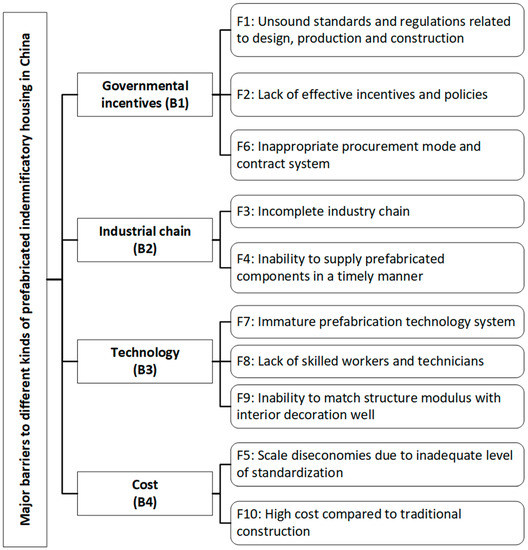
Figure 10.
Hierarchical structure model [61].

Table 11.
Hierarchy of total sorting.
During the investigation and analysis, we found that cost is an important issue in prefabricated housing. The current cost of prefabricated housing is less favourable than that of traditional housing. A higher cost can reduce enterprise enthusiasm and hinder the development of prefabricated housing. There are multiple reasons for higher cost, including: (1) lack of on-site assembly ability, i.e., workers are not familiar with assembly technology, and there are few new specialised subcontracting teams; (2) lack of mature technology and skilled workers, i.e., some technology and skills require complex processes, and since the government has not assessed these processes, the optimal technology cannot be used; (3) high cost of components, i.e., most components are not modularised and standardised and cannot be produced at a large scale; (4) lagging management level, i.e., many enterprises ignore modern management systems and operation modes and lack innovation in management technology.
5.5. Policy Implications
Prefabricated public housing has shown environmental advantages relative to traditional housing, but the government, enterprises and research teams still need to develop prefabricated housing further. Xue et al. (2017) compared prefabrication with traditional on-site construction and concluded that experience, collaborative management and innovative technology are conductive to cost management and development of prefabricated housing [1]. Thus, according to the aforementioned discussion, some policy implications are as follows:
First, research and development are important for training specialised workers and managers. Enterprises and research teams should work together to combine scientific research and practical application and promote technological innovation. Information platforms can strengthen cooperation among different agents and coordinate various types of information and profit-seeking strategies.
Second, pilot work is another way to improve technology and management. Pilot work offers strong examples and is an effective way to promote prefabricated housing. Prefabricated public housing is a suitable trial project. These trial projects and leading enterprises can build experience and provide successful cases for other projects and enterprises. We can then find which types of building structure and categories are suitable and environmentally efficient for prefabricated housing.
Third, prefabrication standards should be improved as soon as possible. Some enterprises indicated that the current standards are too demanding and do not correspond to the actual production situation. In addition to the government, enterprises and social organisations are also encouraged to design enterprise standards and group standards. These standards can then be combined into a set of standard systems. Such systems should be applicable to the design, components, assembly, installation, decorations and even engineering quota and pricing specifications. A high-level component certification system should be built to optimise the production of components.
Moreover, the government should increase public awareness of the benefits of prefabricated housing to create a favourable atmosphere to develop both prefabricated housing and the market.
6. Conclusions
This study analysed the general average condition of prefabricated public housing projects in Beijing based on a questionnaire and field investigation by comparing the costs and environmental benefits of prefabricated public buildings with those of traditional buildings. The cost-benefit method was implemented to analyse the construction costs and environmental benefits, including energy consumption, water usage, construction waste, and attrition of steel and concrete. The paper employed a ∆B/∆C ratio model that could analyse multiple projects without large gaps to analyse the changing rates of costs and benefits to compare environment efficiency. The results constitute a reference to determine the environmental efficiency and problems of prefabricated public housing in Beijing. The key findings are as follows:
- (1)
- According to the survey responses, the Beijing construction budget quota and other case studies, the benefit changing rates have been calculated, and the ∆B/∆C ratio is 1.81, which is greater than one. The ∆B’/∆C ratio of environmental protection is 1.07, which is also greater than one. The investment of prefabricated public housing is environmentally acceptable and efficient. The environmental performance of prefabricated projects is superior to that of traditional projects, but the benefits are not significant, particularly in the area of environmental protection. Prefabricated construction does not save a large amount of energy and is not efficient, nor are the associated water conservation or construction waste reduction efforts significant. The advantages of prefabricated housing, with its limited technology and management, are still not clear. The material attrition rate is better than the environmental protection, but the decrease is below average. In terms of noise and dust pollution, the decrease is also below average, and prefabricated construction still needs to be developed along with the technology and skills.
- (2)
- Cost is an important issue due to the higher cost relative to traditional projects. In accordance with the main obstacle analysis, from the developers’ perspective, cost is the most dominant barrier for developing prefabricated public housing in Beijing. This paper compares the costs of projects with and without government incentives and shows that these two groups have no significant differences. The government has clearly taken some measures to develop prefabricated public housing, but cost remains a key barrier.
- (3)
- With the government incentives, prefabricated projects can proliferate in terms of construction rates. Fixed-price houses and prefabricated shear wall structures are the most environmentally efficient forms of public housing. The government should promote incentives to reduce costs and develop more fixed-price houses and prefabricated shear wall structures.
In conclusion, cost remains a major issue for developing prefabricated housing, and prefabricated construction offers environmental benefits. Despite the fact that the implementation of prefabricated housing remains in the preliminary stage in China, prefabricated housing is expected to play an important role in the housing sector in the coming years. The paper analysed only the average condition of prefabricated public housing in Beijing; different situations exist in different areas. Therefore, more areas should be involved in further research to analyse the average indicators across China. This paper identified only basic environmental impacts of energy consumption, water conservation, construction waste and steel and concrete use as the benefits, but other environmental impacts should be considered, such as the use of cement and unique materials for prefabrication. We anticipate that future research will consider as many environmental impacts of prefabricated housing as possible from the aspect of the entire housing sector and determine more specific issues that hinder the development of prefabricated construction.
Author Contributions
Conceptualisation, K.S., X.L. and Z.Z.; Data curation, K.S. and C.C.; Formal analysis, K.S.; Investigation, K.S.; Methodology, K.S. and C.C.; Validation, K.S.; Writing—original draft, K.S. and C.C.; Supervision, X.L. and Z.Z; Writing—review and editing, X.L.
Funding
This research was funded by the China National Key R&D Program (Grant No. 2018YFC0704400) and the National Natural Science Foundations of China (No. 51778335).
Acknowledgments
The authors would also like to thank the Beijing Public Housing Office for supporting the research process. In addition, the authors are indebted to all the survey interviewees for providing a large amount of data.
Conflicts of Interest
The authors declare no conflict of interest.
References
- Xue, H.; Zhang, S.J.; Su, Y.K.; Wu, Z.Z. Factors Affecting the Capital Cost of Prefabrication—A Case Study of China. Sustainability 2017, 9, 1512. [Google Scholar] [CrossRef]
- Low, S.P. Quantifying the relationships between buildability, structural quality and productivity in construction. Struct. Surv. 2001, 19, 106–112. [Google Scholar]
- Arif, M.; Egbu, C. Making a case for offsite construction in China. Eng. Constr. Arch. Manag. 2010, 17, 536–548. [Google Scholar] [CrossRef]
- Gann, D.M. Construction as a manufacturing process? Similarities and differences between industrialized housing and car production in Japan. Constr. Manag. Econ. 1996, 14, 437–450. [Google Scholar] [CrossRef]
- Li, Z.F. Theory of Housing Industrialization; Science Press: Beijing, China, 2003. (In Chinese) [Google Scholar]
- Cao, X.; Li, X.; Zhu, Y.; Zhang, Z. A comparative study of environmental performance between prefabricated and traditional residential buildings in China. J. Clean. Prod. 2015, 109, 131–143. [Google Scholar] [CrossRef]
- Beijing Municipal Commission of Housing and Urban-Rural Development. Several Guidance on Implementing Green Buildings in Public Housing in Beijing; Beijing Municipal Commission of Housing and Urban-Rural Development: Beijing, China, 2014. (In Chinese)
- Yee, A.A. Social and environmental benefits of precast concrete technology. PCI J. 2001, 46, 14–19. [Google Scholar] [CrossRef]
- Tam, C.M.; Tam, V.W.Y.; Chan, J.K.W.; Ng, W. Use of prefabrication to minimize construction waste—A case study approach. Int. J. Constr. Manag. 2005, 5, 91–101. [Google Scholar] [CrossRef]
- Jaillon, L.; Poon, C.S. The evolution of prefabricated residential building systems in Hong Kong: A review of the public and the private sector. Autom. Constr. 2009, 18, 239–248. [Google Scholar] [CrossRef]
- Zhang, X.; Skitmore, M. Industrialized housing in China: A coin with two sides. Int. J. Strateg. Prop. Manag. 2012, 16, 143–157. [Google Scholar] [CrossRef]
- Ogyiri, V.O. Comparative Cost Analysis of Precast and In Situ Concrete Floor Slabs in Ghana. Master’s Thesis, Department of Building Technology, Kwame Nkrumah University of Science and Technology, Kumasi, Ghana, 2014. [Google Scholar]
- Oranga, B.S. Influence of Prefabricated Houses on the City Housing Problem—A Case of Kibera Slums in Nairobi, Kenya. Master’s Thesis, Department of Extra Mural Studies, University of Nairobi, Nairobi, Kenya, 2012. [Google Scholar]
- Kasper, S.V.; Anne, B. The Construction of Affordable Low Energy Prefabricated Housing in Denmark. In The Design and Construction of High Performance Homes: Building Envelopes, Renewable Energies and Integrated Practice; Routledge: Abingdon-on-Thames, UK, 2013; pp. 203–216. [Google Scholar]
- Pan, W.; Sidwell, R. Demystifying the cost barriers to offsite construction in the UK. Constr. Manag. Econ. 2011, 29, 1081–1099. [Google Scholar] [CrossRef]
- ISO.14040. Environmental Management—Life Cycle—Principles and Framework; British Standards Institution: London, UK, 2006. [Google Scholar]
- Li, D.; Chen, H.; Hui, E.C.; Zhang, J.; Li, Q. A methodology for estimating the lifecycle carbon efficiency of a residential building. Build. Environ. 2013, 59, 448–455. [Google Scholar] [CrossRef]
- Li, X.; Su, S.; Shi, J.; Zhang, Z. An environmental impact assessment framework and index system for the pre-use phase of buildings based on distance-to-target approach. Build. Environ. 2015, 85, 173–181. [Google Scholar] [CrossRef]
- Hong, J.; Shen, G.Q.; Li, Z.; Wang, B.; Zhang, W. Barriers to promoting prefabricated construction in China: A cost-benefit analysis. J. Clean. Prod. 2018, 172, 649–660. [Google Scholar] [CrossRef]
- Zhang, S.; Pan, Y.; Li, N.; Sun, Q. A comparative study of the direct costs between prefabricated housing system and the traditional construction technology—A case study of precast concrete wall panel. In Proceedings of the 18th International Symposium on Advancement of Construction Management and Real Estate; Springer: Berlin/Heidelberg, Germany, 2014; pp. 349–358. [Google Scholar]
- Arditi, D.; Ergin, U.; Günhan, S. Factors Affecting the Use of Precast Concrete Systems. J. Arch. Eng. 2000, 6, 79–86. [Google Scholar] [CrossRef]
- Zhang, X.; Skitmore, M.; Peng, Y. Exploring the challenges to industrialized residential building in China. Habitat Int. 2014, 41, 176–184. [Google Scholar] [CrossRef]
- Klinbuakhao, W.; Tochaiwat, K.; Naksuksakul, S. Factors effecting on decision making in a prefabricated housing: A case study of SCG–Seikisui Sales CO. LTD. In Proceedings of the Built Environment Research Associates Conference, Bangkok, Thailand, 15 July 2016. [Google Scholar]
- Cao, X.; Li, Z.; Liu, S. Study on factors that inhibit the promotion of SI housing system in China. Energy Build. 2015, 88, 384–394. [Google Scholar] [CrossRef]
- Jiang, L.; Li, Z.F.; Li, L.; Gao, Y.L. Constraints on the Promotion of Prefabricated Construction in China. Sustainability 2018, 10, 2516. [Google Scholar] [CrossRef]
- Steinhard, D.A.; Manley, K.; Miller, W.F. Reshaping housing using prefabricated systems. In Proceedings of the World Sustainable Building Conference (SB14), Barcelona, Spain, 28–30 October 2014. [Google Scholar]
- Jaillon, L.; Poon, C.S. Sustainable construction aspects of using prefabrication in dense urban environment: A Hong Kong case study. Constr. Manag. Econ. 2008, 26, 953–966. [Google Scholar] [CrossRef]
- Pan, W.; Gibb, A.F.; Dianty, A.R.J. Perspectives of UK housebuilders on the use of offsite modern methods of construction. Constr. Manag. Econ. 2007, 25, 183–194. [Google Scholar] [CrossRef]
- Pan, W.; Gibb, A.F.; Dainty, A.R.J. Leading UK housebuilders’ utilization of offsite construction methods. Build. Res. Inf. 2008, 36, 56–67. [Google Scholar] [CrossRef]
- Chiang, Y.H.; Chan, E.H.W.; Lok, L.K.L. Prefabrication and barriers to entry—A case study of public housing and institutional buildings in Hong Kong. Habitat Int. 2006, 30, 482–499. [Google Scholar] [CrossRef]
- Blismas, N.G.; Pendlebury, M.; Gibb, A.; Pasquire, C. Constraints to the use of off-site production on construction projects. Arch. Eng. Des. Manag. 2005, 1, 153–162. [Google Scholar] [CrossRef]
- Kamar, K.A.M.; Hamid, Z. Supply chain strategy for contractor in adopting industrialized building system (IBS). Aust. J. Basic Appl. Sci. 2011, 5, 2552–2557. [Google Scholar]
- Park, M.; Ingawale-Verma, Y.; Kim, W.; Ham, Y. Construction policymaking: With an example of Singaporean government’s policy to diffuse prefabrication to private sector. KSCE J. Civ. Eng. 2011, 15, 771–779. [Google Scholar] [CrossRef]
- Mao, C.; Shen, Q.P.; Pan, W.; Ye, K.H. Major barriers to off-site construction: The developer’s perspective in China. J. Manag. Eng. 2014, 31, 1–10. [Google Scholar] [CrossRef]
- Wang, C. Analysis on housing industrialization restraining factors from SST perspective (SST). Shanxi Coking Coal Sci. Technol. 2009, 5, 37–40. (In Chinese) [Google Scholar]
- Shen, L.F. Constraints for housing industrialization in China. Constr. Econ. 2008, 311, 5–8. (In Chinese) [Google Scholar]
- Tudela, A.; Akiki, N.; Cisternas, R. Comparing the output of cost benefit and multi-criteria analysis: An application to urban transport investments. Transp. Res. Part A Policy Pract. 2006, 40, 414–423. [Google Scholar] [CrossRef]
- Yuan, H.; Shen, L.; Hao, J.; Lu, W. A model for cost–benefit analysis of construction and demolition waste management throughout the waste chain. Resour. Conserv. Recycl. 2011, 55, 604–612. [Google Scholar] [CrossRef]
- Begum, R.A.; Siwar, C.; Pereira, J.J.; Jaafarb, A.H. A benefit–cost analysis on the economic feasibility of construction waste minimisation: The case of Malaysia. Resour. Conserv. Recycl. 2006, 48, 86–98. [Google Scholar] [CrossRef]
- Holland, S.; Cross, J. Cost benefit analysis of industrial noise regulation. Econ. Labour Relat. Rev. 1995, 6, 105–124. [Google Scholar] [CrossRef]
- Gao, X.; Asami, Y. Influence of lot size and shape on redevelopment projects. Land Use Policy 2007, 24, 212–222. [Google Scholar] [CrossRef]
- Francisco, L. Urban regeneration economics: The case of Lisbon’s old downtown. Int. J. Strateg. Prop. Manag. 2008, 12, 203–213. [Google Scholar]
- Gabay, H.; Meir, I.A.; Schwartz, M.; Werzberger, E. Cost-benefit analysis of green buildings: An Israeli office buildings case study. Energy Build. 2014, 76, 558–564. [Google Scholar] [CrossRef]
- Liu, Y.; Guo, X.; Hu, F. Cost-benefit analysis on green building energy efficiency technology application: A case in China. Energy Build. 2014, 82, 37–46. [Google Scholar] [CrossRef]
- Winkler, H.; Spalding-Fecher, R.; Tyani, L.; Matibe, K. Cost-benefit analysis of energy efficiency in urban low-cost Housing. Dev. S. Afr. 2002, 19, 593–614. [Google Scholar] [CrossRef]
- Fu, C. Comprehensive Benefit Analysis and Evaluation of the Housing Industrialization. Master’s Thesis, School of Civil Engineering, Dalian University of Technology, Dalian, China, 2015. (In Chinese). [Google Scholar]
- Hao, S. The Study of Housing Industrialization Comprehensive Evaluation Index System and Method. Master’s Thesis, School of Management, Xi’an University of Architecture and Technology, Xi’an, China, 2004. (In Chinese). [Google Scholar]
- Antillón, E.I.; Morris, M.R.; Gregor, W. A value-based cost-benefit analysis of prefabrication processes in the healthcare sector: A case study. In Proceedings of the 22nd Annual Conference of the International Group for Lean Construction, Oslo, Norway, 25–27 June 2014; pp. 25–27. [Google Scholar]
- Beijing Municipal Commission of Housing and Urban-rural Development. Housing Construction and Decoration Project Estimate Quota; Beijing Municipal Commission of Housing and Urban-rural Development: Beijing, China, 2016. (In Chinese)
- Wei, X. Carbon Emissions Calculation and Empirical Analysis on Energy Consumption of Residential Mechanical Equipment in Construction Phase. Master’s Thesis, College of Transportation and Civil Engineering, Fujian Architecture and Forestry University, Fuzhou, China, 2014. (In Chinese). [Google Scholar]
- Zhao, Y.; Wang, L. Construction Waste and Recycle; Chemical Industry Press: Beijing, China, 2004; pp. 5–6. (In Chinese) [Google Scholar]
- Zhu, L.; Ren, H. Research on cutting down the construction’s materials based on circular economy theory. Ecol. Econ. 2007, 5, 187–189. (In Chinese) [Google Scholar]
- Mitkus, M.; Šostak, O.R. Preservation of healthy and harmonious residential and work environment during urban development. Int. J. Strateg. Prop. Manag. 2009, 13, 339–357. [Google Scholar] [CrossRef]
- Huang, T.J. The Monitoring and Analysis of the Health Damage Caused by Fugitive Dust in the Building Construction Phase. Master’s Thesis, Department of Construction Management, Tsinghua University, Beijing, China, 2013. (In Chinese). [Google Scholar]
- He, R.B.; Liu, F. Pollution status and controlling measures of raised dust in city of China. Environ. Prot. Sci. 2003, 29, 1–3. (In Chinese) [Google Scholar]
- Flynn, M.R.; Susi, P. Engineering controls for selected silica and dust exposures in the construction industry—A review. Appl. Occup. Environ. Hyg. 2003, 18, 268–277. [Google Scholar] [CrossRef]
- Sun, Y. Study on the Annoyance Threshold Construction Noise. Master’s Thesis, School of Environmental Science and Engineering, Chang’an University, Xi’an, China, 2008. (In Chinese). [Google Scholar]
- Bies, D.A.; Hansen, C.H. Engineering Noise Control: Theory and Practice; Spon Press: Abingdon, UK, 2009. [Google Scholar]
- Gilchrist, A.; Allouche, E.N.; Cowan, D. Prediction and mitigation of construction noise in an urban environment. Can. J. Civ. Eng. 2003, 30, 659–672. [Google Scholar] [CrossRef]
- Qiu, C. Research on the Construction of Affordable Housing Introduced in Housing Industrialization. Master’s Thesis, School of Management, Jilin Jianzhu University, Changchun, China, 2015. (In Chinese). [Google Scholar]
- Cheng, C.; Shen, K.C.; Li, X.D.; Zhang, Z.Z. Major Barriers to Different Kinds of Prefabricated Public Housing in China: The Developers’ Perspective. In Proceedings of the International Conference on Construction and Real Estate Management, Guangzhou, China, 10–12 November 2017; pp. 79–88. [Google Scholar]
© 2019 by the authors. Licensee MDPI, Basel, Switzerland. This article is an open access article distributed under the terms and conditions of the Creative Commons Attribution (CC BY) license (http://creativecommons.org/licenses/by/4.0/).